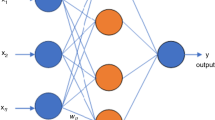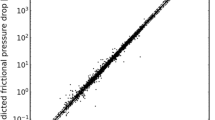Abstract
In recent years, extensive research efforts have been devoted to flow boiling heat transfer mechanisms in macro and mini-channels. However, it is still difficult to predict the flow boiling heat transfer coefficient with satisfactory accuracy. In this study, support vector regression (SVR) models have been constructed using a respectable experimental database (767 samples) from the literature to predict the heat transfer coefficient of R11 in mini-channels for subcooled (324 samples) and saturated (443 samples) boiling regions. The prediction performance of the SVR-based models have been evaluated based on the statistical parameters. SVR-based models have been found to exhibit an average absolute relative error (AARE) of 1.7% and correlation coefficient (R) of 0.9996 for subcooled boiling, while for saturated boiling the values of AARE and R are 1.6% and 0.9993, respectively. Also, the developed SVR-based models have been compared with the well-known existing correlations. The superior prediction performance of SVR-based models has been observed with the lowest value of AARE and the highest value of correlation coefficient (R). Furthermore, parametric effects of mass flux, vapor quality, heat flux and pressure on the flow boiling heat transfer coefficient have also been investigated and the SVR-based models have been found to agree well with the experimental results.










Similar content being viewed by others
Abbreviations
- Bo:
-
Boiling number
- C :
-
Cost function
- Co :
-
Convective number
- C p :
-
Specific heat, J/kg.K
- Dh :
-
Hydraulic diameter, m
- f (x):
-
Regression function
- G :
-
Mass flux, kg/m2.s
- h :
-
Heat transfer coefficient, kW/m2.K
- h lg :
-
Enthalpy of vaporization, J/kg
- k:
-
Thermal conductivity, W/m.K
- K(xi,xj):
-
Kernel function
- L :
-
Dual form of the Lagrangian function
- P :
-
Fluid pressure, kPa
- Pe:
-
Peclet number
- Pr:
-
Prandtl number
- Q2 ext :
-
Leave-one-out cross validation for the test set
- Q2 Loo :
-
Leave-one-out cross validation for the training set
- R:
-
Correlation coefficient
- Re:
-
Reynolds number
- S:
-
Suppression factor
- T:
-
temperature, K
- q :
-
heat flux density, W/m2
- xi :
-
Input vector
- Xtt :
-
Lockhart-Martinelli parameter
- y i :
-
Output vector
- l:
-
Liquid phase
- nb:
-
Nucleate boiling
- sat:
-
Saturated
- tp:
-
Two-phase
- v:
-
Vapor phase
- w:
-
Wall
- Γ:
-
Surface development parameter
- σ:
-
Width parameter of RBF kernel
- ε:
-
Loss function
- γ:
-
Regularization parameter
- λ and λ*:
-
Lagrange multipliers
- ϕ(x i):
-
High dimensional mapping feature function for input vector x
- K :
-
Thermal conductivity, W/m.K
- μ:
-
Kinematic viscosity, kg/m.s
- ρ:
-
Density, kg/m3
- σ:
-
Surface tension, N/m
- AARE:
-
Average absolute relative error
- ANN:
-
Artificial neural network
- MRE:
-
Mean relative error
- RBF:
-
Radial basis function
- SVM:
-
Support vector machines
- SVR:
-
Support vector regression
- SRM:
-
Structural risk minimization
- RMSE:
-
Root mean square error
- SD:
-
Standard deviation
References
Rao M, Khandekar S (2009) Simultaneously Developing Flows Under Conjugated Conditions in a Mini-Channel Array: Liquid Crystal Thermography and Computational. Heat Transf Eng 30:751–761. https://doi.org/10.1080/01457630802678573.
Thakkar K, Kumar K, Trivedi H (2014) Thermal & Hydraulic Characteristics of Single phase flow in Mini-channel for Electronic cooling – Review. Int J Innov Res Sci Eng Technol 3:9726–9733
Kandlikar SG (2002) Fundamental issues related to flow boiling in minichannels and microchannels. Exp Thermal Fluid Sci 26:389–407. https://doi.org/10.1016/S0894-1777(02)00150-4
Joshi LC, Singh S, Kumar SR (2014) A review on enhancement of heat transfer in microchannel heat exchanger. Int J Innov Sci Eng Technol 1:529–535
Qu W, Mudawar I (2003) Flow boiling heat transfer in two-phase micro-channel heat sinks -I. Experimental investigation and assessment of correlation methods. Int J Heat Mass Transf 46:2755–2771. https://doi.org/10.1016/S0017-9310(03)00041-3
Copetti JB, Zinani F, Ayres FGB, Schaefer F (2015) Boiling heat transfer in Mini Tube: A discussion of two phase heat transfer coefficient behaviour, flow patterns and heat transfer correlations for two refrigerants, IV Journeys Multiph. Flows (JEM 2015), 1–9
Li W, Wu Z (2010) A general criterion for evaporative heat transfer in micro/mini-channels. Int J Heat Mass Transf 53:1967–1976. https://doi.org/10.1016/j.ijheatmasstransfer.2009.12.059
Xiande F, Rongrong S, Zhanru Z (2011) Correlations of Flow Boiling Heat Transfer of R-134a in Minichannels : Comparative study. Energy Sci Technol 1:1–15
Piasecka M (2014) Application of heat transfer correlations for FC-72 flow boiling heat transfer in minichannels with various orientations. MATEC Web Conf 18:1–8
Mahmoud MM, Karayiannis TG (2013) Heat transfer correlation for flow boiling in small to micro tubes. Int J Heat Mass Transf 66:553–574
Basu S, Ndao S, Michna GJ, Jensen MK (2011) Flow Boiling of R134a in Circular Microtubes -Part I: Study of Heat. J Heat Transf 133:051502–051509. https://doi.org/10.1115/1.4003159.
Olayiwola NO (2005) Boiling in Mini and Micro-Channels. M. S. Thesis, School of mechanical Engineering, Georgia Institute of Technology, Atlanta
Olayiwola NO, Ghiaasiaan SM (2006) Assessment of flow boiling heat transfer correlations for application to mini-channels. In: 2006 ASME Int. Mech. Eng. Congr. Expo., ASME, Chicago, pp. 1–16
Bao ZY, Fletcher DF, Haynes BS (2000) Flow boiling heat transfer of Freon R11 and HCFC123 in narrow passages. Int J Heat Mass Transf 43:3347–3358. https://doi.org/10.1016/S0017-9310(99)00379-8
Baird JR, Bao ZY, Fletcher DF, Haynes BS (2000) Local flow boiling heat transfer coefficients in narrow conduits. Multiph Sci Technol 12:129–144. https://doi.org/10.1615/MultScienTechn.v12.i3-4.80
Yan Y-Y, Lin T-F (1998) Evaporation heat transfer and pressure drop of refrigerant R-134a in a small pipe. Int J Heat Mass Transf 41:4183–4194
Peng H, Ling X (2015) Predicting thermal-hydraulic performances in compact heat exchangers by support vector regression. Int J Heat Mass Transf 84:203–213. https://doi.org/10.1016/j.ijheatmasstransfer.2015.01.017.
Zaidi S (2012) Development of support vector regression (SVR)-based model for prediction of circulation rate in a vertical tube thermosiphon reboiler. Chem Eng Sci 69:514–521. https://doi.org/10.1016/j.ces.2011.11.005.
Shabri A, Suhartono (2012) Streamflow forecasting using least-squares support vector machines. Hydrol Sci J 57:1275–1293. https://doi.org/10.1080/02626667.2012.714468
Bui Tien D, Pham BT, Nguyen QP, Hoang N-D (2016) Spatial prediction of rainfall-induced shallow landslides using hybrid integration approach of Least-Squares Support Vector Machines and differential evolution optimization: a case study in Central Vietnam. Int J Digit Earth 9:1077–1097. https://doi.org/10.1080/17538947.2016.1169561
Thissen U, Van Brakel R, De WP, Melssen WJ, Buydens LMC (2003) Using support vector machines for time series prediction. Chemom Intell Lab Syst 69:35–49. https://doi.org/10.1016/S0169-7439(03)00111-4
Burbidge R, Trotter M, Buxton B, Holden S (2001) Drug design by machine learning : support vector machines for pharmaceutical data analysis. Comput Chem 26:5–14
Parveen N, Zaidi S, Danish M (2016) Support vector regression model for predicting the sorption capacity of lead (II). Perspect Sci 8:629–631
Parveen N, Zaidi S, Danish M (2017) Support Vector Regression Prediction and Analysis of the Copper (II) Biosorption Efficiency. Indian Chem Eng 59:295–311. https://doi.org/10.1080/00194506.2016.1270778
Vapnik V, Golowich SE, Smola A (1996) Support Vector Method for Function Approximation, Regression Estimation, and Signal Processing. Adv Neural Inf Proces Syst 9:281–287
Gunn S (1997) Support Vector Machines for Classification and Regression, ISIS Technical Report. University of Southampton, Southampton, pp 1–42
Zaidi S (2015) Novel application of Support Vector Machines to model the two phase-boiling heat transfer coefficient in a vertical tube thermosiphon reboiler. Chem Eng Res Des 98:44–58. https://doi.org/10.1016/j.saa.2011.10.074.
Parveen N, Zaidi S, Danish M (2017) Development of SVR-based model and comparative analysis with MLR and ANN models for predicting the sorption capacity of Cr(VI). Process Saf Environ Prot 107:428–437. https://doi.org/10.1016/j.psep.2017.03.007.
Vapnik VN (1995) The Nature of Statistical Learning Theory. Springer, New York
Pan Y, Jiang J, Wang R, Cao H, Cui Y (2009) Predicting the auto-ignition temperatures of organic compounds from molecular structure using support vector machine. J Hazard Mater 164:1242–1249. https://doi.org/10.1016/j.jhazmat.2008.09.031.
Sriraam A, Sekar S K, Samui P (2012) Support Vector Machine Modelling for the Compressive Strength of Concrete, In: B.H.V. Topping (Ed.), Proc. Eighth Int. Conf. Eng. Comput. Technol., Civil-Comp Press, Scotland, pp. 1–15
Nachev A, Stoyanov B (2012) Product quality analysis using support vector machines. Int J Inf Model Anal 1:179–192
Smola AJ, Schölkopf B (2004) A tutorial on support vector regression. Stat Comput 14:199–222. https://doi.org/10.1023/B:STCO.0000035301.49549.88
Chen JC (1966) Correlation for boiling heat transfer to saturated fluids in convective flow. Ind Eng Chem Process Des Dev 5:322–329
Gungor KE, Winterton RHS (1987) Simplified general correlation for saturated flow boiling and comparison with data. Chem Eng Res Des 65:148–156
Kandlikar S G, (1990) Flow boiling maps for water, R-22 and R-134a in the saturated region. In: Int. Heat Transf. Conf., Jerusalem, pp. 1–6
Lazarek GM, Black SH (1982) Evaporative heat transfer, pressure drop and critical heat flux in a small vertical tube with R-113. Int J Heat Mass Transf 25:945–960
Lee J, Mudawar I (2005) Two-phase flow in high-heat-flux micro-channel heat sink for refrigeration cooling applications: Part II — heat transfer characteristics. Int J Heat Mass Transf 48:941–955. https://doi.org/10.1016/j.ijheatmasstransfer.2004.09.019
Liu Z, Winterton RHS (1991) A general correlation for saturated and subcooled flow boiling in tubes and annuli , based on a nucleate pool boiling equation. Int J Heat Mass Transf 34:2759–2766
Mohammad PE, Shah M (1982) Chart correlation for saturated boiling heat transfer : Equations and further study. ASHRAE Trans 88:185–196
Warrier GR, Dhir VK, Momoda LA (2002) Heat transfer and pressure drop in narrow rectangular channels. Exp Thermal Fluid Sci 26:53–64
Piasecka M (2015) Correlation for flow boiling heat transfer in minichannels with various orientations. Int J Heat Mass Transf 81:114–121
Shi XZ, Zhou J, Wu BB, Huang D, Wei W (2012) Support vector machines approach to mean particle size of rock fragmentation due to bench blasting prediction. Trans Nonferrous Metals Soc China 22:432–441. https://doi.org/10.1016/S1003-6326(11)61195-3
Lee C-Y, Chern S-G (2013) Application of a Support Vector Machine for Liquefaction Assessment. J Mar Sci Technol 21:318–324. https://doi.org/10.6119/JMST-012-0518-3.
Chang C-C, Lin C-J (2011) A Library for Support Vector Machines, ACM Trans. Interlligent Syst. Technology 2:1–27. https://doi.org/10.1145/1961189.1961199
Jung Y (2018) Multiple predicting K -fold cross-validation for model selection. J Nonparametr Stat 30:197–215. https://doi.org/10.1080/10485252.2017.1404598
Chang Q, Chen Q, Wang X (2005) Scaling Gaussian RBF kernel width to improve SVM classification. In: Int. Conf. Neural Networks Brain, 2005 ICNN, Beijing
Bertsch SS, Groll EA, Garimella SV (2009) Effects of heat flux, mass flux, vapor quality, and saturation temperature on flow boiling heat transfer in microchannels. Int J Multiphase Flow 35:142–154. https://doi.org/10.1016/j.ijmultiphaseflow.2008.10.004
Yan J, Bi Q, Liu Z, Zhu G, Cai L (2015) Subcooled flow boiling heat transfer of water in a circular tube under high heat fluxes and high mass fluxes. Fusion Eng Des 100:406–418. https://doi.org/10.1016/j.fusengdes.2015.07.007.
Acknowledgments
Authors sincerely extend their thanks and gratitude to Messrs. Z.Y. Bao, D.F. Fletcher and B.S. Haynes for the availability of their published work from which the flow boiling heat transfer data has been retrieved for model formulation and validation. Authors also want to acknowledge Messrs. N.O. Olayiwola and S.M. Ghiaassiaan from whom we got the motivation for carrying out the present research.
Author information
Authors and Affiliations
Corresponding author
Additional information
Publisher’s Note
Springer Nature remains neutral with regard to jurisdictional claims in published maps and institutional affiliations.
Rights and permissions
About this article
Cite this article
Parveen, N., Zaidi, S. & Danish, M. Modeling of flow boiling heat transfer coefficient of R11 in mini-channels using support vector machines and its comparative analysis with the existing correlations. Heat Mass Transfer 55, 151–164 (2019). https://doi.org/10.1007/s00231-018-2459-3
Received:
Accepted:
Published:
Issue Date:
DOI: https://doi.org/10.1007/s00231-018-2459-3




